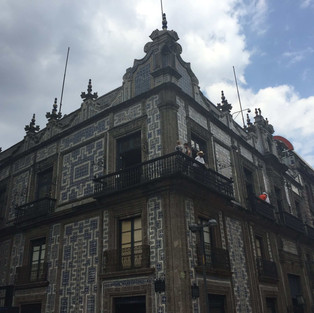Mexico City, MEXICO - Latin America’s Largest City with a Colonial Splendor.
- Guest Blogger

- Nov 16, 2020
- 7 min read
Updated: Mar 9, 2022
Mexico City offers a unique combination of modern city life, historic public places. museums, colonial architecture, vibrant neighborhoods, parks, restaurants, and the remains of several cultures make it a must-visit urban destination.
Guest Blogger: Suk & Sangy, Urge to XPLORE
Disclosure: Our site contains Affiliate Links. Clicking an Affiliate Link and purchasing something we recommend, won't cost you anything extra - it probably will save you some bucks. It will though give us a small commission which will help this site remain a free resource for travelers to explore our world together.

Mexico City or Ciudad de Mexico CDMX as the locals call it is a sprawling metropolis with grand public parks, boulevards, innovative public architecture, museums, and chic shopping districts making it an amazing urban destination. It has one of the largest plazas in the Americas, a huge public park twice the size of New York’s Central Park, most museums after Paris, and tens of thousands of restaurants. While it is undoubtedly one of the most exciting food cities, its art scene both folk and modern is equally interesting. But the best thing about this city is affordability be it food or attractions.

Start your day early at the Centro Historico commonly referred to as Zócalo the largest plaza in the whole of Latin America. It is the vibrant historic center of the city that is always bustling with people. This is truly the heart and soul of the city with colonial architecture, murals in art deco buildings, museums, and taquerias. Prior to the colonial period, this was the ceremonial center of the Aztecs. Officially known as Plaza de la Constitución, it is surrounded by the Palacio Nacional, Catedral Metropolitana, City Hall, and Government buildings.
Catedral Metropolitana is the one of oldest and the largest in Latin America. Built over the ruins of the Aztec Temple its construction spanned over three centuries and the architecture is an amalgamation of different styles that prevailed during those times. The interiors are stunningly beautiful with ornate décor, grand altars, towering ceilings, and gold coatings. One can also climb the stairs to the bell towers as part of a tour for sweeping views of the Zocalo.
Visit the Templo Mayor that Aztecs considered the center of the universe You can spend almost an entire day in and around Zocalo walking down the narrow alleys and cobblestone streets to gaze at the many art deco buildings like the Tile house, or take a tour of the Palacio Nacional which has huge colorful murals by Diego Rivera.
To the western side of Centro Historico is the Palacio de Bellas Artes or the Palace of Fine Arts. Often called the Art Cathedral of Mexico City, it hosts notable events in music, dance, theatre, opera, and literature and as well as exhibitions of painting, sculpture, and photography. Next to this beautiful building is the city’s oldest urban park called the Alameda Central. The area which used to be an Aztec marketplace is now a green garden with paved paths, fountains, and statues.

Inside the park is the. Benito Juárez Monument commemorating the Mexican president and statesman Benito Juárez. Close to the Palace in Mexico City’s iconic skyscraper Mirador Torre Latino. There are museums and telescopes on the upper floors with an observation deck on its top floor that offers panoramic views of the city. The area around Alameda Central Park has many museums, shopping centers, and restaurants. Once you walk down the other end of the park from the Palace of Fine Arts you will reach Avenida Paseo de la Reforma.

It is wide avenue 15km long that runs diagonally across the center of the city. Modeled after great European boulevards, it is lined up with modern skyscrapers on either side with roundabouts that houses some of city’s prominent landmarks like Monumento a la Revolución and Monumento a la Independencia..The Revoloution monument was built to commemorate the Mexican Revolution contains tombs of the revolution hereos. An elevator takes you to the top of the monument.
The Independence monument also known El Ángel is a victory column and one of the most recognizable landmarks in city. Walking down the avenue will take you to Bosque de Chapultepec one of the largest ecological park in the in the western hemisphere. Centered on a rock formation called Chapultepec Hill, it has a zoo, a botanical garden, a recreational lake and many museums.

Of the many museums in the city, our favorite picks are Museo Soumaya and Museo de Frida Kahlo. Located in the upscale Polanco neighborhood , the Soumaya museum named after the late wife of Mexican billionaire Carlos Slim is a shining example of futuristic architecture inside and outside. This free to enter museum is all of 6 stories high with spectacular interiors boasting of an extensive collection of artefacts and art work by old and modern European masters such as Rodin, Dali amongst others. The museum of Frida Kahlo is located in the bohemian neighborhood Coyoacán.


Coyoacán also known as La Casa Azul meaning the Blue House because of the Cobalt blue walls, it is a historic house and art museum dedicated to the life and work of Mexican artist Frida Kahlo. As one of the oldest colonial neighborhoods Coyoacan with it’s cobblestoned streets and colonial architecture provides a glimpse of the bygone era. It has a historic center, the Jardín Centenario park, the Mercado de Coyoacan and the Mercado Artesanal. You get to savor some of the best taco in Coyoacan market and the Artesan / Craft market has some of best apparel, souviniers and handicrafts. The are numerous sidewalk cafes, laid back ice cream parlors pubs and restaurants along the tree-lined avenue.


Around Mexico City
Be it Pyramids, Canals, Volcanoes, or Colonial Towns, there are many attractions outside the city that can be covered in half-day or full-day tours. On the southern fringes of the city is Xochimilco famous for its floating gardens and canals. It is the last remnants of a vast water transport system built by the Aztecs. It is a festive atmosphere on weekends with colorful boats taking visitors on a cruise while passing by food vendors, artisans stalls, and bands. You can also visit the awe-inspiring Aztec pyramids at Teotihuacan, which is about an hour away from Mexico City. Teotihuacán has two famous pyramids known as the Temple of the Sun and the Temple of the Moon. Both Canals and the Pyramids can be covered in half-day tours. The one tour we recommend is a full-day tour of Puebla & Cholula.

Just a couple of hours' drive from the city, Puebla & Cholula are like the colonial cousins of Mexico City. On the way, you also get to see the famous volcanic peaks of Popocatépetl and Iztaccihuatl. Puebla is known for its culinary history, colonial architecture, and pottery.
As you approach the city center, you see the dome-shaped roofs of churches and buildings, suggesting Spanish and Moor influences that arrived centuries ago. The Renaissance-era Puebla Cathedral has the tallest bell towers in the whole of Mexico and overlooks the central square of this picturesque city. Adjacent to the cathedral, you’ll find the Casa de la Cultura which takes up a whole block and hosts, among other things, the oldest library in the Americas.

RELATED POST: Is Mexico Safe to Hike and Backpack?

Downtown Puebla is small but consists of hundreds of civil and religious monuments behind extraordinary facades, gardens, and balconies which have been steadily added to the landscape over the years.

Cholula’s claim to fame is that it’s home to the world’s largest pyramid. Pyramid Tepanapa. It’s the world’s largest pyramid by volume; bigger than the Great Pyramid in Egypt. There is a Church at the top of the hill at Cholula. The hill is actually the top part of the pyramid. The views from the top are outstanding with the volcanos in the back. Downtown Cholula is dotted with colonial-era churches, shops selling traditional artifacts, and restaurants serving local cuisine.


Best Place to Stay
Like any big city, Mexico City has many neighborhoods that cater to every type of traveler. Often for most travelers, areas around Centro Historico is the preferred one due to the proximity to the major attractions. Then you have the upscale and modern neighborhoods Polanco and Santa Fe with high-end dining and shopping. The twin neighborhood of Condesa and Roma are a blend of urban and bohemian with its eclectic bars, exquisite restaurants, and boutiques this is perfect for young and independent travelers. Our recommendation is for a colonial neighborhood of Coyoacán to get the feel of true Mexican culture.
Best Time to Visit
Mexico City is generally pleasant throughout the year due to its elevation (almost 7400 feet above sea level). The spring (March to May) and Fall ( September to November) are the best times are the best time when the weather is fairly dry and pleasant. Summer months are wet whereas Winter temperatures can drop to freezing at night.
Transportation
The best way to get around is Uber which is very cheap, and taxis are also available everywhere. The Metro system is very extensive and as a matter of fact, its network is the second largest in North America after NYC. Most of the tourist attractions are easily accessible by metro trains with fares as low as a quarter.
Currency
Mexico’s official currency is the Mexican Peso MXN. It is represented by the “$” symbol
Recommended Itinerary
A 3 - 4-day itinerary can cover most of the sights within the city but not all of them. Keep a day for a day tour outside the city. Keep in mind it’s also a foodie paradise and you will end up spending most of the evening trying out the amazing food everywhere you go.

Guest Bloggers Suk & Sangy are a couple living in Toronto Canada with a nomadic soul. They have been traveling the world together for many years now and have been to many places across 5 continents. As the pandemic put a restriction on their travel plans, they decided to spend their time sharing their past travel experiences through their blog – Urge to XPLORE. Also, follow them on their Instagram!



















Comments